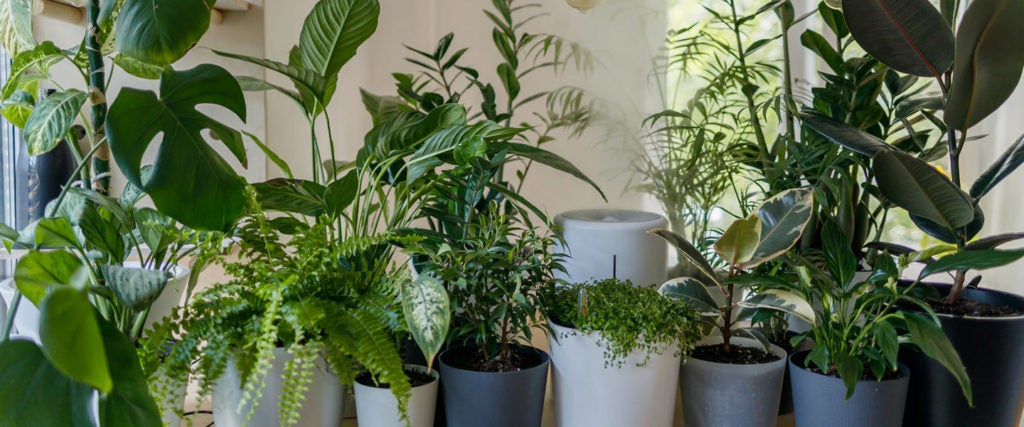Houseplants have some incredible qualities. They help you focus. They improve your mood. They even increase your overall hotness on Instagram. But pick the wrong houseplant, and it can kill your dog.
To make sure that never happens, Jerry Klein, chief veterinary officer at the American Kennel Club, and Tina Wismer, senior director of the ASPCA Animal Poison Control Center, helped me put together a list of the most common (and most evil) plants that are poisonous to dogs.
What Plants Are Toxic to Dogs?
Lily of the Valley. Its bell-shaped flowers may look harmless, but the lily of the valley plant houses a dense population of cardiac glycosides, which can cause potentially lethal cardiac disturbances if consumed by both humans and domestic animals. The same can be said for many plants in the digitalis family, more commonly known as foxgloves.
Oleander. “Although arguably beautiful, every part of an oleander plant is poisonous,” Klein says. “Ingesting it can cause a range of symptoms, from dizziness to vomiting, and may even lead to death, especially in the case of pets and small children.” Fuck oleanders then.
Philodendron. “Philodendron is a very popular houseplant,” Wismer says. “It contains insoluble calcium oxalate crystals that, when ingested, can cause pain and irritation in the mouth and lips. Very rarely, we can see swelling in the mouth, causing difficulty breathing.”
Castor Bean. More commonly grown outdoors, but sometimes grown indoors, “Castor bean is highly toxic and can cause severe stomach upset, liver failure and tremors,” Wismer warns.
Peace Lily. “This low-maintenance plant is commonly given as a gift, but it’s poisonous to humans and pets,” Klein warns. “Ingestion can cause drooling, vomiting and swelling of the lips, tongue and upper airway.” Moreover, Klein says, “Most lilies are extremely toxic,” so you probably want to avoid them altogether.
Sago Palm. You think a sago palm will make your apartment more tropical, but it thinks, Ima kill your dog! “The leaves and seeds of sago palms are toxic,” says Klein. “While humans may only suffer some discomfort if they ingest it, the plant is extremely dangerous to dogs and can lead to liver damage.” Wismer adds, “All parts of this plant are poisonous, however, the seed or ‘nuts’ contain the largest amount of toxins.”
ZZ Plant. “ZZ plants are very common, sold at just about every garden center,” Klein explains. “They’re also noxious to humans and pets. While not as dangerous as oleanders, we probably wouldn’t keep any around if we had curious pups.” Common symptoms of ingestion include burning and irritation of the mouth, and excessive drooling.
Snake Plant. Coveted for being low maintenance, snake plants are extremely popular, but equally dangerous. “Large doses can cause nausea and vomiting, and the poison found in the plant has a numbing effect that can cause the tongue and throat to swell,” Klein says. Nope, we can’t have that!
Mistletoe. Sure, you can kiss under the mistletoe, but don’t let your dog kiss (or eat) the plant itself. “Mistletoe is widely reported to be poisonous,” says Klein. “Vomiting and diarrhea may result when eaten, but usually the effects are short-lived.”
Holly. Another plant that can make your dog terribly sick while simultaneously spreading holiday cheer, holly “can result in mild to moderate gastrointestinal upset,” according to Klein.
Poinsettia. While not incredibly dangerous, “Dogs who eat poinsettia may show irritation of the mucous membranes, hypersalivation and vomiting,” Klein says. “These symptoms rarely require medical intervention; however, if you’re concerned, contact your vet.”
Kalanchoe. Also known as flaming Katy, kalanchoe “contain molecules related to the cardiotoxic compounds of poisonous toads that can poison the hearts of animals,” Klein explains. “Dogs are particularly sensitive to the cardiotoxic effects of kalanchoe. They have experienced vomiting, diarrhea and depression after ingestion of this plant.” How dare kalanchoes make our dogs sad!
And More!
The sad truth is, there are a hell of a lot of poisonous plants out there. “There are also dangerous plants to look out for while doing outdoor gardening,” Klein says. “A number of common flowers and plants can be unsafe — or even fatal — for dogs, so it’s important to do research on the plants that you’ll be using in your garden.” He specifically suggests avoiding calla lilies, azalea and rhododendron. “Bulb plants such as tulips, daffodils and crocus can also be toxic if ingested,” Klein adds. “Additionally, be mindful of flowers and plants that have thorns, as these can be dangerous for your pup as well.”
“If you do have one of these plants, make sure to keep it in a place that your pet doesn’t have access to,” Wismer says. “Typically, this includes making a physical barrier, as many deterrents aren’t consistently effective, and with some plants, a single exposure could be life threatening.”
For more information, the ASPCA has an exhaustive database with hundreds of plants that are poisonous to dogs (and other animals) — as well as several lists of dog-safe plants — so if you’re planning on plant shopping anytime soon, your best bet is to make a tally of plants you like, then compare. “Do your research, and if you think your dog has ingested something potentially harmful, always consult with your veterinarian right away,” Klein says.
On second thought, you could just choose one or the other. Who needs plants when you have a dog, anyway?

